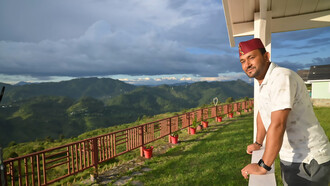We were told to expect something quite special, magnificent even, at our next destination, after having tasted the hospitality to be found in the splendid Niquesa establishment in Rome, Hotel d‘Inghilterra. In the day and age of alluring online presentations, something common and mundane can be portrayed as being out of the ordinary so the promising images of Grand Hotel Continental in Siena, however imposing, had to be put to the test. Waiting for us at the elegantly decorated terminal in Florence was our driver, who the hotel had most graciously provided to take us to Siena and as it turned out was a most pleasant representative of a hotel truly out of the ordinary.
Upon arrival in Siena’s exquisite Centro Storico, the medieval heart of this ancient city and a World Heritage site, we realised that we had found our sojourn in luxury – our room a masterpiece, designed for the tastes of the 17th century aristocracy and refined to meet the demands of the modern traveller. The hotel‘s accommodation is unashamedly opulent and stands as a testament to the talent of the artisans who crafted it. The palazzo revels in its magnificence, from the imaginative frescoes that adorn the ceilings to the Carrara marble and expansive limestone floors, beautifully marked with the patina of 500 years of aristocratic footsteps. The pictures had not been a deception, reality far exceeded the images and the much overused word luxury seemed somehow inadequate here.
From our hotel’s privileged position, as the early spring air cooled in the late afternoon, it was time to stroll down cobbled medieval lanes to the city’s most important architectural features, the Siena‘s cathedral and the famous Piazza del Campo where the the world’s most famous bareback horse race embodies the real soul of Siena. This annual festival of beauty and danger showcases the incredible sense of togetherness and competition amongst the local community and reverberates a little bit of ancient rivalries. Our walk revealed a jewel box selection of delicatessens, restaurants and bars, but in addition to its picturesque cityscape, Siena is famous for a rich tradition of arts and artists and the city remains a vital cultural centre. Another theme for a walk in Siena would be finding its fountains of which Siena has many.
On our return we learned that various guided tours are available to guests, Siena being well-placed to explore the Tuscan countryside, gentle rolling hills lined with cypress trees and some of the best vineyards in all Italy. So we decided to ask the concierge to arrange for a tour to the renowned village of Montalcino, to step away from the city into wine country, not only represented by the famous Chianti but more interestingly by the famous Brunello di Montalcino. Along with the medieval masterpieces of Montepulciano, Lucca and San Gimignano, not forgetting the Renaissance gem, Florence, a mere hour away this would be a day to remember. But for all its beauty Florence is closer to modernity than Siena which retains more of a medieval charm and calmness than its more successful old rival. We were happy to have chosen it as our dwelling place.
Looking forward to taste the Brunello di Montalcino the next day we decided to choose other good representatives of Tuscan wine making to complement our dinner at Sapordivino restaurant claimed to be a testament to the art of Italian culinary prowess, where Chef Luca Ciaffarafà inspires you to taste, listen, recognise and appreciate his own brand of Tuscan mastery. In its simplicity, Sienese food is said to capture the essential flavours and ingredients of Tuscany from local farming. We opted for Chicken stuffed with prunes on bread crouton and mixed vegetables and slow cooked angler fish with tomato cream, clams and julienne of purple potato followed by almond pudding with seaside honey and rosemary ice cream, - with no regrets.
One long-standing characteristic is said to identify the Sienese: their proverbial mistrust of neighbours. The old rivalry with Florence and later between the seventeen Contradas played out at the Palio bears evidence to this. There is a saying: ‘Chi t'accarezza più di quel che sòle, o t'ha 'ngannato o 'ngannà ti vole’ - He who flatters you excessively has either deceived you or intends to do so. So when leaving our marvellous hotel we found it appropriate to temper our praise. But to others we have no such reservations. This is a place for your bucket list.
For more information:
www.niquesahotels.com















